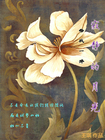A night wondrously clear and of a colour unknown to our climate; a place of dreamlike aspect, fraught with mystery. The moon of a bright silver, which dazzles by its shining, illumines a world which surely is no longer ours; for it resembles in nothing what may be seen in other lands. A world in which everything is suffused with rosy color beneath the stars of midnight, and where granite symbols rise up, ghostlike and motionless.
Is that a hill of sand that rises yonder? One can scarcely tell, for it has as it were no shape, no outline; rather it seems like a great rosy cloud, or some huge, trembling billow, which once perhaps raised itself there, forthwith to become motionless for ever. . . . And from out this kind of mummified wave a colossal human effigy emerges, rose-coloured too, a nameless, elusive rose; emerges, and stares with fixed eyes and smiles. It is so huge it seems unreal, as if it were a reflection cast by some mirror hidden in the moon. . . . And behind this monster face, far away in the rear, on the top of those undefined and gently undulating sandhills, three apocalyptic signs rise up against the sky, those rose-coloured triangles, regular as the figures of geometry, but so vast in the distance that they inspire you with fear. They seem to be luminous of themselves, so vividly do they stand out in their clear rose against the deep blue of the star-spangled vault. And this apparent radiation from within, by its lack of likelihood, makes them seem more awful.
And all around is the desert; a corner of the mournful kingdom of sand. Nothing else is to be seen anywhere save those three awful things that stand there upright and still--the human likeness magnified beyond all measurement, and the three geometric mountains; things at first sight like exhalations, visionary things, with nevertheless here and there, and most of all in the features of the vast mute face, subtleties of shadow which show that /it/ at least exists, rigid and immovable, fashioned out of imperishable stone.
Even had we not known, we must soon have guessed, for these things are unique in the world, and pictures of every age have made the knowledge of them commonplace: the Sphinx and the Pyramids! But what is strange is that they should be so disquieting. . . . And this pervading colour of rose, whence comes it, seeing that usually the moon tints with blue the things it illumines? One would not expect this colour either, which, nevertheless, is that of all the sands and all the granites of Egypt and Arabia. And then too, the eyes of the statue, how often have we not seen them? And did we not know that they were capable only of their one fixed stare? Why is it then that their motionless regard surprises and chills us, even while we are obsessed by the smile of the sealed lips that seem to hold back the answer to the supreme enigma? . . .
It is cold, but cold as in our country are the fine nights of January, and a wintry mist rises low down in the little valleys of the sand.
And that again we were not expecting; beyond question the latest invaders of this country, by changing the course of the old Nile, so as to water the earth and make it more productive, have brought hither the humidity of their own misty isle. And this strange cold, this mist, light as it still is, seem to presage the end of ages, give an added remoteness and finality to all this dead past, which lies here beneath us in subterranean labyrinths haunted by a thousand mummies.
And the mist, which, as the night advances, thickens in the valleys, hesitates to mount to the great daunting face of the Sphinx; and covers it with the merest and most transparent gauze; and, like everything else here to-night, this gauze, too, is rose-colored. And meanwhile the Sphinx, which has seen the unrolling of all the history of the world, attends impassively the change in Egypt's climate, plunged in profound and mystic contemplation of the moon, its friend for the last 5000 years.
Here and there on the soft pathway of the sandhills are pigmy figures of men that move about or sit squatting as if on the watch; and small as they are, low down in the hollows and far away, this wonderful silver moon reveals even their slightest gestures; for their white robes and black cloaks stand sharply out against the monotonous rose of the desert. At times they call to one another in a harsh, aspirate tongue, and then go off at a run, noiselessly, barefooted, with burnous flying, like moths in the night. They lie in wait for the parties of tourists who arrive from time to time. For the great symbols, during the hundreds and thousands of years that have elapsed since men ceased to venerate them, have nevertheless scarcely ever been alone, especially on nights with a full moon. Men of all races, of all times, have come to wander round them, vaguely attracted by their immensity and mystery. In the days of the Romans they had already become symbols of a lost significance, legacies of a fabulous antiquity, but people came curiously to contemplate them, and tourists in toga and in peplus carved their names on the granite of their bases for the sake of remembrance.














